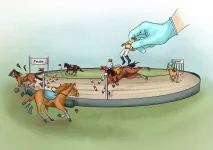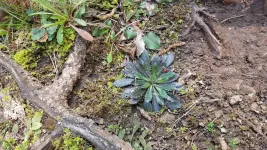New system for tracking macaws emphasizes species' conservation needs
Researchers with Texas A&M's Macaw Society used satellite telemetry to track the movements of 10 birds over a period of 8 years.
2021-07-14
(Press-News.org) New data on macaw movements gathered by the Texas A&M University College of Veterinary Medicine & Biomedical Sciences' (CVMBS) The Macaw Society has the potential to greatly improve conservation strategies for the scarlet macaw, as well as similar species of large parrots.
While the overall conservation status of the scarlet macaw is listed as "least concern" by the International Union for Conservation of Nature, the species is declining across much of Central America and in other parts of its range in South America. The species also shares its habitat with numerous endangered species and influences the ecosystems in which it lives.
The Macaw Society's paper, recently published in Avian Conservation & Ecology, is the result of the long-term research study of the ecology and conservation of macaws and other parrots in Peru's Tambopata National Reserve.
Historically, the migratory movements of large parrots and macaws have largely remained a mystery because of the difficulty of tracking them over the long distances they travel. The recent publication describing the discoveries made using satellite tracking of individual birds over large areas has shed some light on this mystery.
The research team -- consisting of associate professor Donald Brightsmith; adjunct associate professor Janice Boyd; Elizabeth Hobson from the University of Cincinnati; and Charles Randel from the Southwestern Wildlife Survey in California -- used ARGOS satellite telemetry (orbiting satellites that detect signals emitted from a transmitter attached to an animal) to track six scarlet macaws and four blue-and-yellow macaws over a period of eight years.
They found that both macaw species had very large home ranges, consisting of thousands of hectares (with 1 hectare equaling 2.471 acres), and often traveled 20 to 40 km (approximately 12 to 25 miles) per day. Individuals of both species moved up to 160 km (99 miles) during the periods of low food availability, likely searching for areas with dense patches of food trees.
New data on macaw movements gathered by the Texas A&M University College of Veterinary Medicine & Biomedical Sciences' (CVMBS) The Macaw Society has the potential to greatly improve conservation strategies for the scarlet macaw, as well as similar species of large parrots.
While the overall conservation status of the scarlet macaw is listed as "least concern" by the International Union for Conservation of Nature, the species is declining across much of Central America and in other parts of its range in South America. The species also shares its habitat with numerous endangered species and influences the ecosystems in which it lives.
The Macaw Society's paper, recently published in Avian Conservation & Ecology, is the result of the long-term research study of the ecology and conservation of macaws and other parrots in Peru's Tambopata National Reserve.
Historically, the migratory movements of large parrots and macaws have largely remained a mystery because of the difficulty of tracking them over the long distances they travel. The recent publication describing the discoveries made using satellite tracking of individual birds over large areas has shed some light on this mystery.
The research team -- consisting of associate professor Donald Brightsmith; adjunct associate professor Janice Boyd; Elizabeth Hobson from the University of Cincinnati; and Charles Randel from the Southwestern Wildlife Survey in California -- used ARGOS satellite telemetry (orbiting satellites that detect signals emitted from a transmitter attached to an animal) to track six scarlet macaws and four blue-and-yellow macaws over a period of eight years.
They found that both macaw species had very large home ranges, consisting of thousands of hectares (with 1 hectare equaling 2.471 acres), and often traveled 20 to 40 km (approximately 12 to 25 miles) per day. Individuals of both species moved up to 160 km (99 miles) during the periods of low food availability, likely searching for areas with dense patches of food trees.
INFORMATION:
ELSE PRESS RELEASES FROM THIS DATE:
2021-07-14
The concept of interoperability describes the ability of different systems to communicate. This is a major challenge in biomedical research, and in particular, in the field of personalised medicine, which is largely based on the compilation and analysis of numerous datasets. For instance, the COVID-19 pandemic has shown that even when the technical, legal and ethical constraints are lifted, the data remain difficult to analyse because of semantic ambiguities. Under the auspices of the Swiss Personalized Health Network (SPHN) and in close collaboration with representatives from all five Swiss university ...
2021-07-14
Superconductivity is a physical phenomenon where the electrical resistance of a material drops to zero under a certain critical temperature. Bardeen-Cooper-Schrieffer (BCS) theory is a well-established explanation that describes superconductivity in most materials. It states that Cooper pairs of electrons are formed in the lattice under sufficiently low temperature and that BCS superconductivity arises from their condensation. While graphene itself is an excellent conductor of electricity, it does not exhibit BCS superconductivity due to the suppression of electron-phonon interactions. This is also the reason that most 'good' conductors such as gold and copper are 'bad' ...
2021-07-14
The corona pandemic has ensured that the term "mRNA" is now also known to a large public beyond laboratories and lecture halls. However, the molecule is much more than an important component of a successful vaccine against the SARS-CoV-2 virus. "mRNAs are a central component of all living things on our planet. Without them life as we know it would not function," says Elmar Wolf.
Wolf is a professor for tumour system biology at the Department of Biochemistry and Molecular Biology at the University of Würzburg. With his research team, he has now deciphered new details about the formation of mRNA which provide novel insights into how a fundamental process inside cells works: the transcription. The team ...
2021-07-14
A team of researchers, affiliated with UNIST has succeeded in developing a new optical microscope technology, capable of deeper imaging beyond the biological tissues. This breakthrough has been led by Professor Jung-Hoon Park and his research team in the Department of Biomedical Engineering at UNIST.
Optical imaging technology has emerged as an essential research tool for biomedical studies due to its high resolution and good tomography capability. However, the limited penetration depth of the optical microscope makes it difficult to observe biological tissues of more than 100 μm thickness. This is because strong light scattering, caused by various components ...
2021-07-14
New York, NY--July 13, 2021--The past decade has witnessed scandal after scandal over private images maliciously or accidentally made public. A new study from computer scientists at Columbia Engineering reveals what may be the first way to encrypt personal images on popular cloud photo services, such as those from Google, Apple, Flickr and others, all without requiring any changes to -- or trust in -- those services.
Smartphones now make it easy for virtually everyone to snap photos, with market research firm InfoTrends estimating that people now take more than a trillion photos each year. The limited ...
2021-07-14
A new study reveals the strategies that stop bandits from illegally fishing in Australian waters--but warns there is a cost to the region's poorer countries.
Co-author Dr Brock Bergseth, from the ARC Centre of Excellence for Coral Reef Studies at James Cook University, said poachers are simply following the recurring history of human fishing: intensively fish and devastate local resources, then move further afield to--in these cases--fish illegally or poach in other countries' waters.
"Millions of people rely on fish and seafood and when offered no alternative choice, will chose banditry and illegal fishing ...
2021-07-14
A new method of DNA testing on cocoa beans could revolutionise the chocolate industry, offering consumers greater reassurance about the origins and ethics of their beloved confectionery, and giving the global cocoa industry a precision tool to help end slavery and child labour.
Researchers from the University of Bath, University of the West of England, and Surrey Business School have proven a low-cost method which compares DNA in chocolate products to the cocoa when it is farmed. This means cocoa can be reliably traced back from an individual chocolate bar to the specific farms which cultivated the cocoa in it, a major advance on current fairtrading, certification and sustainability practices.
"This has the potential to ...
2021-07-14
What the fruit fly is to zoologists, the thale cress is to botanists. The widespread herb with the botanical name Arabidopsis thaliana serves them as a model organism from which knowledge can be gained for other plants. It is therefore extremely well researched - also genetically. For example, it is now known that the genetic material of Arabidopsis thaliana (its genome) comprises around 125 million base pairs. It's like having a Lego manual in front of you that is 125 million letters long and contains everything you need to know to build an Arabidopsis plant.
Similar to humans, different Arabidopsis specimens are generally not genetically identical. If you were to compare the construction manual of all plants of this species, you would encounter differences in about 10 million places, ...
2021-07-14
Dr. Iair Arcavi, a Tel Aviv University researcher at the Raymond and Beverly Sackler Faculty of Exact Sciences, participated in a study that discovered a new type of stellar explosion - an electron-capture supernova. While they have been theorized for 40 years, real-world examples have been elusive. Such supernovas arise from the explosions of stars 8-9 times the mass of the sun. The discovery also sheds new light on the thousand-year mystery of the supernova from A.D. 1054 that was seen by ancient astronomers, before eventually becoming the Crab Nebula, that we know today.
A supernova is the explosion of a star following a ...
2021-07-14
A new study co-authored by the UBC Sauder School of Business has found that when senior managers mistreat workers, middle managers often attempt to quietly smooth things over.
Robin Hood was known for stealing from the rich and giving to the poor -- but while he may have lived in Sherwood Forest centuries ago, he would have fit right in as a middle manager in today's business world.
Studies have shown that when employees are mistreated by senior leaders, employees can often get back at them by doing things like gossiping, stealing office supplies or calling in sick when they're well. But according to new research from UBC Sauder, middle managers also get in on the act, and attempt to address workplace injustices by secretly helping out their subordinates ...
LAST 30 PRESS RELEASES:
[Press-News.org] New system for tracking macaws emphasizes species' conservation needs
Researchers with Texas A&M's Macaw Society used satellite telemetry to track the movements of 10 birds over a period of 8 years.





